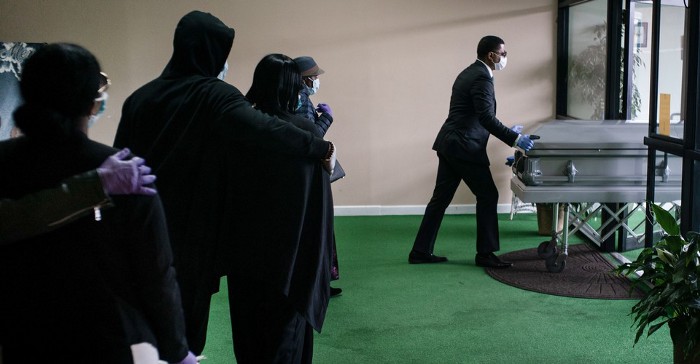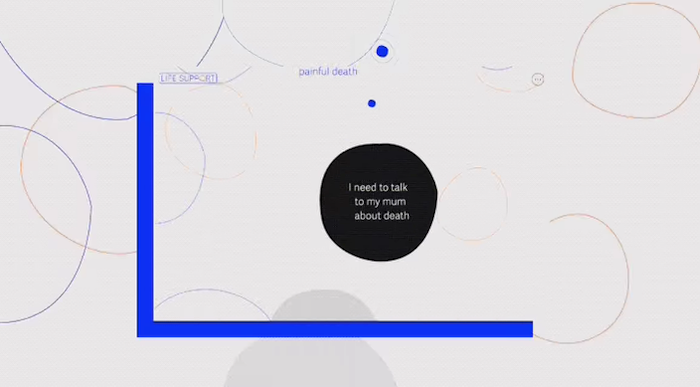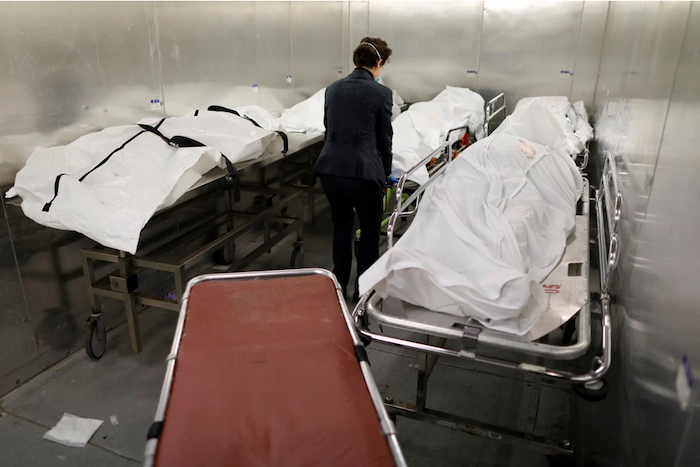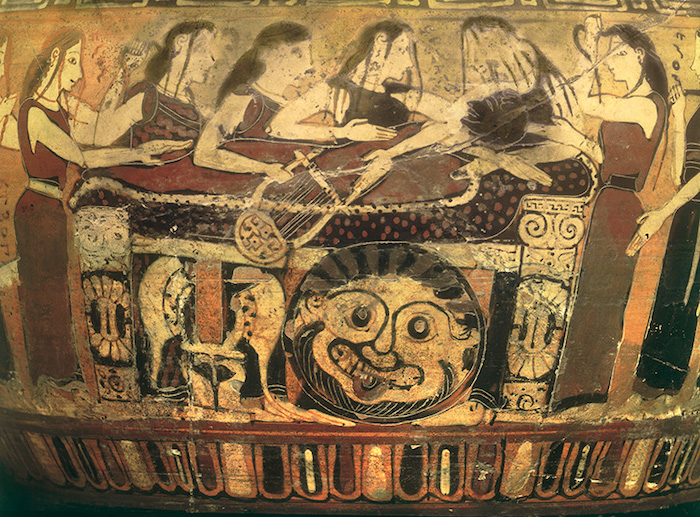Mourning on a wintry day at the end of a year that has all been winter.
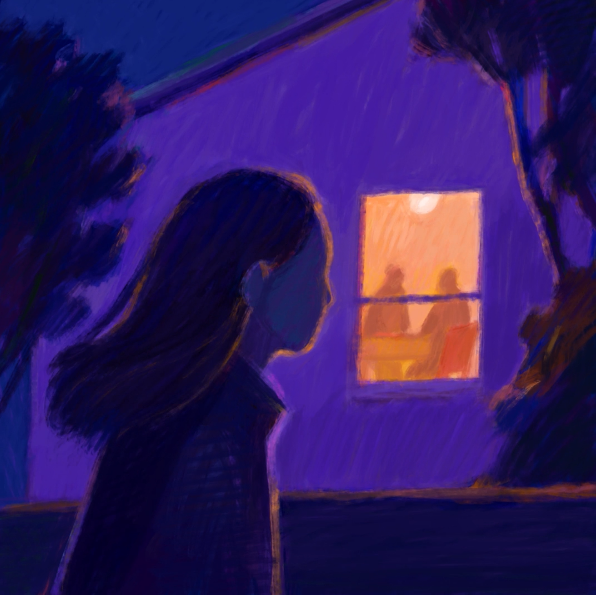
By Dur e Aziz Amna
I walk out, steering the stroller with icy fingers. I pass the house that always appears as if someone is moving in or out, the gray house with a garage full of ugly toys, the white house with an attractive couple who dine every day at 7 p.m., which I know because I peek in on my daily quarantine walks, comforted by the sight of the woman’s top bun and the man’s beard as they sit across from each other at a farmhouse table.
Today is winter. A crisp, cold, sunny day, the kind that makes you think for a few hours that perhaps this — the end of the year in Michigan — isn’t too bad. But when I reach the park, it is all sorrow. Each blade of grass, shimmering in December light, is sorrow. The crackle of each remaining leaf is sorrow.
Muslims recite the azan — the call to prayer — in the ear of every newborn, but we leave it out of the final prayer for the deceased. The point is that our time here is as brief as the moment between the call to prayer and the start of prayer. Now, in the park, the journey each drop of melted snow makes from branch to wilted grass is sorrow.
For those, like me, living far from home, there is a worry so common it is banal: the Call. The call that comes when a loved one is hurt or dying. We brace ourselves against it, convinced that anticipation is inoculation against grief. To this day, I sleep with my phone on silent only when I am back in Pakistan; home is the place where late-night calls don’t seize the ground beneath you.
In Michigan, when the phone rings in the middle of the night, it’s usually just a wrong number or a relative who thinks America is five hours behind and not 10. Sometimes though, it is a sunny morning, the house smells of coffee and the baby is playing with tiny toes when the phone rings, and something in you, that animal that senses danger before it manifests, tells you that it’s bad news.
My husband once asked my father if he believed in saints. Abbu responded that if there was any saint in his life, it was his last surviving uncle, Chacha Jee. On Dec. 1, Chacha Jee died, his lungs, liver and heart collapsing in quick succession in an emergency ward in Pindi, Pakistan.
The official diagnosis was pneumonia, but the symptoms were close enough to Covid-19 for them to transfer him to the Covid ward. No family was allowed to visit him in his final moments. Globally, 1.6 million people have died of the disease this year. Many were also isolated from their loved ones in their last days, even if they lived in the same town, let alone across the world.
Faiz Ahmad Faiz, the famous Urdu poet, wrote that during his years in prison, time collapsed so that “the occurrences of a century seem to be like the happenings of yesterday.” Grief, particularly of the remote kind, seems to work in the same way.
Suddenly, I am 5 again, and Chacha Jee and his wife, Baji, have come over, armed with the Sandwich House they painstakingly made for our birthday parties. There is a garden of lettuce leaves and cottages made of sliced bread. In the middle stands Mr. Potato, on legs of toothpicks, with a bit of carrot for a nose.
Then I am 9, spending sticky summer afternoons at their house, Chacha Jee making the hot chai such a hot day calls for.
Then I am 25 and sharing sly smiles with my brothers because Chacha Jee is singing his favorite song: “Tu Ganga ki mauj main Jamna ka dhara /Ho rahega milan yeh humara tumhara.” (You are the wave of the Ganges, I am a stream of the Jamuna /Our union is bound to happen.)
These are the happenings of yesterday, yet far more real than the ephemera of sun grazing the backyard, my foggy breath, my mother’s voice over WhatsApp, saying that Chacha Jee has passed.
My father was only 30 when my grandmother died, and often relatives would try to reminisce about her with him. Abbu, resolutely private in his mourning, firm in his belief that one takes grief to the prayer mat and leaves it there, would quote the poet Ahmed Faraz. “Dukh fasana nahi ke tujh se kahen /Dil bhi mana nahi ke tujh se kahen.” (Neither was my grief a story, that I may tell you /Nor did my heart agree, that I may tell you.)
In the style of a child forever looking up to her father, I aspire to that, but that is not how I process grief. Instead, even as I am on the phone, I think to myself, I will write into and out of this.
“What skies this earth has inhaled,” wrote Ameer Minai, and Chacha Jee was that — a benevolent sky over everyone who knew him. Born in a rural Punjabi village where men rarely spoke to children and never showed affection to their wives, Chacha Jee carved out a path of his own. I remember him arranging saucers, pouring out cups of chai for Baji and himself. Complimenting the little frocks my cousins and I wore for Eid, when every other man would consider that frivolous.
The sun is now setting upon that world, but without a doubt, that world was there. I saw it — where the worth of a man was his brooding silence, his coldness, his anger. There was that line of fathers, haughty and unforgiving. And there was that childless father of us all, Chacha Jee, laughing his shrill, girlish laughter, joking with everyone, treating even the youngest child with wonder and love and curiosity.
He was a captain in the Pakistan Army. Sent to Germany for training, he tricked an American officer into believing the pungent taramira oil he used to smooth his hair was a Pakistani delicacy to be enjoyed by the spoonful. At 82, he drove himself from Pindi to our home village in Talagang every other week, although my love for him will not allow me to sugarcoat this: Chacha Jee was a truly terrible driver, with a recklessness that was not complimented by capability.
If Chacha Jee was modern enough to have shunned those older, tormented ways of being, he was still hospitable in a way that only someone brought up in the communality of the village could be. He settled in the city but brought the wide-open doors of the dhok with him. When I had a fever and my mother was not around, Abbu deposited me at Chacha Jee and Baji’s house for the night, because there was no one in the family who cared for the sick as they did.
A Palestinian friend tells me that in Arabic they say, “Ili raba ma maat”: The one who raises others never dies.
Now I am a mother, and I find that grieving with a child is odd. The world tumbles on its axis, and yet complete despair seems impractical, because there is a hungry mouth to be fed, a pair of curious eyes watching as you weep. That day we learned that Chacha Jee was gone, my youngest brother, who was visiting, and I kept seeking the baby, not for catharsis (babies are terrible, squirmy huggers) but for comfort. He is new. He has years and years and years, inshallah. He will go places, to spots in time, where none of us will.
“Your absence has gone through me,” W.S. Merwin wrote, “Like thread through a needle. /Everything I do is stitched with its color.” And so it is with being a parent; every feeling, high or low, is refracted through that identity, considered in the context of that tiny body lolling around on the lime green quilt. Chacha Jee, then, is another part of my life that I will not be able to share with my children. I add him to the tablet full of real things — people I touched, places I trod — that will live on only as stories. And yes, stories are important. I know that because why else would I be here with you?
My mother tells me of a time when she visited her grandfather. He was remembering the people he had known in his life, laughing mostly to himself as he relayed this story or that. Ammi sat with him, mostly out of deference, slightly impatient because she didn’t know any of the people he was talking about. Suddenly, she realized that he was telling her all this because everyone who did know the people in his stories was gone.
Children can be brutal to the past. My brother remembers standing in a row for our grandfather’s funeral prayer and having a 4-year-old cousin whisper to him, “I bet it’s going to be Grandma next.” Everyone was together in the village for three days of mourning, during which the little kids ran around, hopping from one house to another. For months they remembered those days with extreme fondness. “We had such fun at Grandpa’s funeral,” they remarked.
But I am obsessed with my parents, and given the way these things go, there is a decent chance that my children will be, too, not for my sake but because that is where any honest attempt at understanding their own selves would lead them. Lives should be led in the present, the eye has to look to the future, but all meaning is past.
So where does that leave us, on this wintry day at the end of a year that has all been winter? In the past, I have been embittered by mourning deceased family members from afar, while everyone back home gets together and seeks catharsis in crowded rooms. This time, we are all far apart.
In 2020, the congregation of grief is online. We call one another and spin stories, which we then rehear from others and wonder: Did this story start with me, or are we all saying the same things? On the family thread, I send a screenshot of Chacha Jee laughing with his mouth wide open, the baby curled up in tummy time in the top right corner. A cousin quotes Khalid Sharif: “Bichra kuch iss ada se ke rut hi badal gayi /Ik shakhs saray shehr ko veeran kar gaya.” (He left, and the season changed /He left, and left the city desolate.)
For my brother, more resolute in his faith than I am, the consolation is clear. As Muslims, we believe that Muhammad will never abandon a lover of Muhammad. And Chacha Jee loved Muhammad, the cousin and daughter and grandsons of Muhammad, the followers of Muhammad, and beyond. Chacha Jee will be at peace. It is us, the living, that I worry about.
I worry for Baji, who will wake up without a partner of more than 50 years; her loss is its own universe. My father and mother, who will miss the kindest shadow in their lives. And us — my brothers and I, the baby. Life will distract us; it is good at doing that. We will have other people to love and be loved by.
All day, my brother and I hummed softly to ourselves, stray lyrics that let us obliquely touch the place that hurt. I started “Tu Ganga ki Mauj” but stopped after a verse. The next morning, I put on the coffee and turned on a song by Mehdi Hassan: “Muhabbat karne walay kam na honge /Teri mehfil mein lekin hum na honge.” (Your congregation will still have other lovers /It’s just that I will be there no more.)
Complete Article ↪HERE↩!
